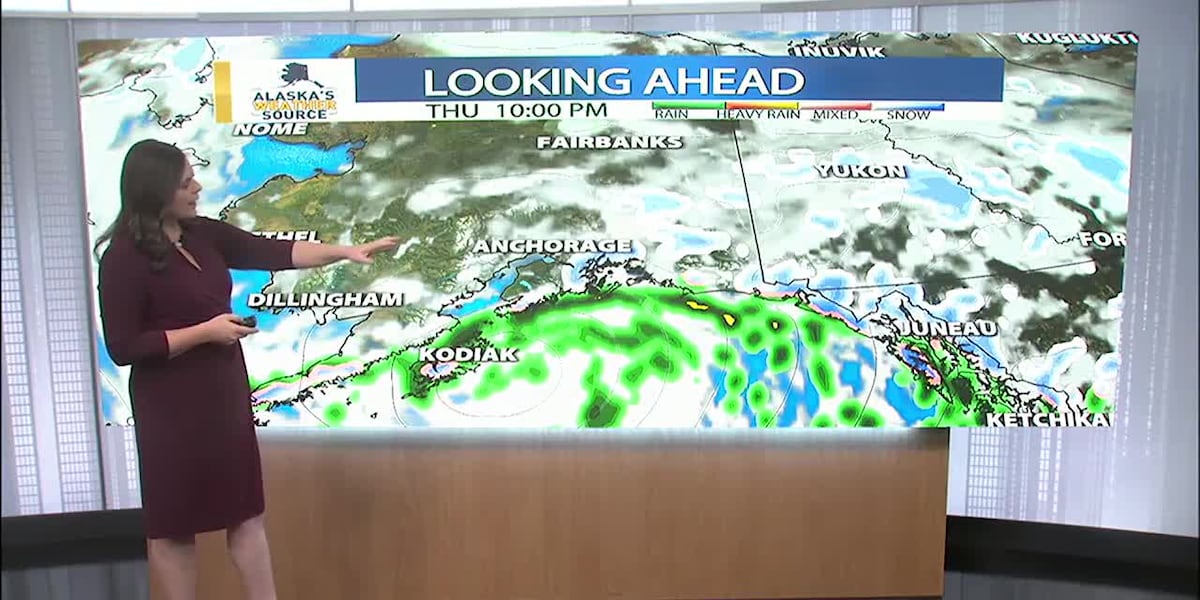Alaska
Bill adding more Indigenous languages to Alaska’s official list heads to governor

Alaska lawmakers passed a bill last week that adds several Indigenous languages to Alaska’s official list of languages.
A version of the bill, sponsored by Juneau Rep. Andi Story, was approved by the Senate and then OK’d by the House last week. It was originally passed in the House last year. Now it heads to the governor.
Earlier this year, Story, a Democrat, called the changes included in the bill an important step in recognizing all of the 23 distinct Alaska Native languages in the state.
“This reflects the goal of sustaining and reinvigorating Alaska Native languages, a concept that goes beyond preservation,” she said.
The languages that the bill adds to the official list are Cup’ig, Middle Tanana, Lower Tanana and Wetał. Middle and Lower Tanana were previously classified as just one language.
According to a recent report from the council, there are currently no high-proficiency speakers of the Wetał language. It comes from the Portland Canal region of Southeast Alaska and British Columbia.
The bill also expands and renames the Alaska Native Language Preservation and Advisory Council. The council advocates to promote the survival and revitalization of Indigenous languages in the state. It will now be called the Council for Alaska Native Language.
The bill adds two seats to the council and moves it from the Department of Commerce to the Department of Education and Early Development to better emphasize the council’s focus on education.
In testimony earlier this year, the chairman of the council, X̱ʼunei Lance Twitchell, said he supports the bill and argued Indigenous languages need to be a bigger priority for the state. Twichell teaches Alaska Native languages at the University of Alaska Southeast.
“Alaska Native languages are the oldest living resource in Alaska,” he said. “These languages are older than the trees, they’re older than some of the rocks, and none of us are qualified to make the decision that they should not exist anymore.”
He said it’s crucial that these languages are recognized as the valuable and historic resources that they are.
“Every single Alaska Native language is sacred and irreplaceable,” he said. “It contains concepts that cannot be translated, it contains things that cannot be replaced, and that give a sense of fulfillment and wholeness and health to Alaska Natives and to non-natives in Alaska.”
The bill passed unanimously in the Senate. In the House, only Rep. David Eastman, a Wasilla Republican, voted against it. He argued some of the languages proposed, like Wetał, are not spoken regularly and should not be added to the official list.
A spokesperson for Gov. Mike Dunleavy did not directly respond to questions asking whether the governor plans to sign the bill.

Alaska
Golovin awaits arrival of 2 delayed power generators

As average temperatures plunge five degrees each week in Golovin, the western Alaska village is anxiously awaiting the arrival of two new generators.
The generators were made possible by a $218,098 grant from Norton Sound Economic Development Corporation and were expected to be delivered earlier in the fall. Golovin Power Utility’s bookkeeper, Joann Fagerstrom, said that with winter looming workers have had to improvise due to delays.
“They could have came here with a tender boat if they got here a lot sooner. But they were stuck in Bethel for a while, and they got to Nome last week,” Fagerstrom said.

As sea ice begins to appear throughout the Bering Strait region, the utility plans on flying in the generators. But another problem has arisen: the new generators, John Deere 6090 marine-grade engines, are too tall to fit inside the CASA C-212 cargo plane.
First, the generators will need to be disassembled. Fagerstrom said that with some help from Nome-based mechanic Noah Burmeister, workers will be able to break the generators down and fly them to Golovin.
Each generator can output up to 222 kilowatts, enough to power the entire village on its own. This increased capacity will allow Golovin to prolong wear and tear on the new units while providing redundancy.
Fagerstrom said the utility expects the generators to arrive in the coming weeks and be online in time for winter.
Alaska
Scientists discover volcano-like structure in Arctic Ocean off Alaska • Alaska Beacon
Scientists aboard a U.S. Coast Guard icebreaker have discovered something unusual in the Arctic Ocean off northern Alaska: a volcano-like structure rising more than 500 meters from the seafloor and possibly emitting gas.
The discovery came as scientists from different organizations were aboard the Healy, one of two polar-class Coast Guard icebreaking cutters, were working on a mission to better understand uncharted waters in the Chukchi and Beaufort seas north of Alaska.
Although the structure rises well above the seabed, it tops out at about 1,600 meters below the water’s surface, so it is too deep to pose any risks to navigation, the Coast Guard said in a statement. However, there appears to be a plume of gas rising from the structure that nearly reaches the water’s surface, the Coast Guard said.
The discovery is part of a project called the Alaskan Arctic Coast Port Access Route Study. The project is surveying what have been uncharted waters and collecting depth data along a corridor that the Coast Guard has proposed to be a preferred vessel route between Utqiagvik, the nation’s northernmost community, and the U.S.-Canada border. The project is making use of equipment aboard the Healy to gather data and create detailed images of the seafloor and objects along the proposed Utqiagvik-to-Canada corridor.
Multiple organizations are collaborating on the project, which is in its first phase: the U.S. National Science Foundation, the National Oceanic and Atmospheric Administration, and the University of New Hampshire, along with the Coast Guard.
Capt. Meghan McGovern, the commanding officer of the NOAA Ship Fairweather, is part of the Healy mapping team and commented on the discovery.
“Although data analysis is ongoing, these findings are exciting and offer insight into what may exist beneath the ocean’s surface, much of which is unknown in this region,” McGovern said in a Coast Guard statement. “The coordination and partnerships during this mission fill critical gaps in the region for all waterway users and provide a foundation for safe navigation in the Arctic.”
The port access route study accomplishments came despite some difficulties endured earlier in the year by the Healy, its crew and its visiting scientists.
The Healy had to cut short one of its Arctic research cruises after a fire broke out in its electrical system in July, when the ship was sailing off the coast of Canada’s Banks Island. The Healy returned to its home port of Seattle for repairs, then sailed back north on Oct. 1 to resume this year’s Arctic mission.
The Healy is the only Coast Guard icebreaker designed to support scientific research. This year, it hosted 20 early career scientists, along with their mentors, to help them gain Arctic research experience and skills.

GET THE MORNING HEADLINES.
Alaska
Temperatures begin downward trend across Alaska this weekend

ANCHORAGE, Alaska (KTUU) – A week of warm temperatures during the day and below-freezing conditions overnight makes for an icy mess across Southcentral.
In addition to the warm weather, windy and wet conditions continue for the coastal areas of Southcentral, Southwest, and Southeast Alaska as a storm turns near Kodiak.
This storm will stick with us one more day, before moving on to the east. That means Seward, Portage, and Whitter will see rain on Friday, with showers also likely in Homer, Valdez, and Cordova. The higher elevations, including Turnagain Pass, will likely see a wintry mix Thursday night through Friday.
Anchorage will stay mild on Friday, with temperatures starting out slightly below freezing before warming back to the mid-30s in the afternoon.
An extended stretch of storm-free weather is likely starting this weekend. But with drier and clearer conditions, it also means temperatures will steadily fall 2 to 4 degrees with each day. Get ready for teens and 20s in Anchorage and the Mat-Su by the middle part of next week.
Copyright 2024 KTUU. All rights reserved.
-
Business1 week ago
Carol Lombardini, studio negotiator during Hollywood strikes, to step down
-

 Health1 week ago
Health1 week agoJust Walking Can Help You Lose Weight: Try These Simple Fat-Burning Tips!
-
Business7 days ago
Hall of Fame won't get Freddie Freeman's grand slam ball, but Dodgers donate World Series memorabilia
-

 Culture6 days ago
Culture6 days agoYankees’ Gerrit Cole opts out of contract, per source: How New York could prevent him from testing free agency
-

 Culture4 days ago
Culture4 days agoTry This Quiz on Books That Were Made Into Great Space Movies
-

 Business1 week ago
Business1 week agoApple is trying to sell loyal iPhone users on AI tools. Here's what Apple Intelligence can do
-
/cdn.vox-cdn.com/uploads/chorus_asset/file/25299201/STK453_PRIVACY_B_CVirginia.jpg)
/cdn.vox-cdn.com/uploads/chorus_asset/file/25299201/STK453_PRIVACY_B_CVirginia.jpg) Technology7 days ago
Technology7 days agoAn Okta login bug bypassed checking passwords on some long usernames
-

 Politics1 week ago
Politics1 week agoTrump pledges 'America's new golden age' as he rallies in PA's post-industrial third-largest city
















